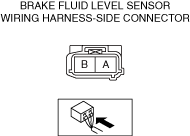Description
Brake system warning light turns on
Possible cause
• Brake fluid level is low
• Brake fluid level sensor stuck on
• Short to ground in brake fluid level sensor signal circuit
• Electronically controlled brake unit connector is disconnected (circuit that turns on ABS warning light, TCS/DSC operation indicator light, brake system warning light, and TCS OFF indicator light if electronically controlled brake unit connector is disconnected)
• Electronically controlled brake unit detects malfunction (input/output device malfunction)
• Electronically controlled brake unit detects decrease in power supply voltage
• Poor ground in electronically controlled brake unit (If electronically controlled brake unit ground is not secured properly, ABS warning light, TCS/DSC operation indicator light, brake warning light, and TCS OFF indicator light turn on, but no DTC is output)
• Electronically controlled brake unit does not activate
• Electronically controlled brake unit internal malfunction
• Instrument cluster malfunction


